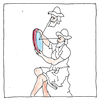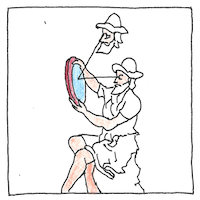Abu-‘Ali Al-Hasan ibn
Al-Haytham (Alhazen)
optics

|
Optics
Alhazen was familiar with the work of Aristotle, Ptolemy, and Euclid and worked to correct the errors in their understanding of optics. Alhazen stressed the need for experimentation. Euclid was wrong; Aristotle was right; we see not from light emitted by our eyes but from light entering them. Alhazen held that light is emitted or reflected from objects at all angles but he struggled to understand how we see images clearly when a profusion of rays from every point hits the eyes at different angles. It must be, he said, that our eyes see only rays that hit them perpendicularly.
Camera obscura
Translation into Latin gave us our spelling “Alhazen,” which today would not be transliterated the same way. Alhazen wrote over two hundred books in Arabic, but only fifty-five have survived and not all of these have been translated into English. An image projected through a pinhole lens is dim and rotated one hundred and eighty degrees.
Optical lessons
Some objects emit light, some reflect it, some refract or defract it, and some absorb it. Some are opaque; others are transparent or partly transparent to all or only some colors. The angle of light that hits a mirror is equal to the angle of light that bounces off. Prisms, lenses, and small openings refract light, bending it toward the perpendicular when entering a lens and away from the perpendicular when leaving. Thomas Young’s famous double-slit experiment demonstrated diffraction and proved light is a wave. Heisenberg and others showed it’s also a beam of particles. Light travels in an elliptical wave and many wavelengths can travel together incoherently, but a polarized filter blocks waves in all but one direction. So here I am this rainy morning, thinking there ought to be many analogies in optics to intellectual and spiritual enlightenment, whether I am a source of light or reflect it, whether, being optically dense, I refract light, and whether I am incoherent or polarized. I sit in my living room on the couch, enjoying the gurgling and pitter-patting of rain. If the sun were to peek from the clouds, I would be willing to go outside to look for the promised rainbow.



Alhazen’s book Maqala fi al-Hala wa Qaws Quzah (“On the Rainbow and Halo”) proposed an incorrect theory how a rainbow forms. The correct theory for the primary rainbow was proposed by Theodoric of Freiberg in 1304, and René Descartes explained the secondary rainbow in 1637. Even so, Descartes did not understand the nature of color, thinking that each color was a modification of white light. In 1672, Isaac Newton explained that white light is composed of a spectrum of colored light.
See also in The book of science:
Readings in wikipedia: